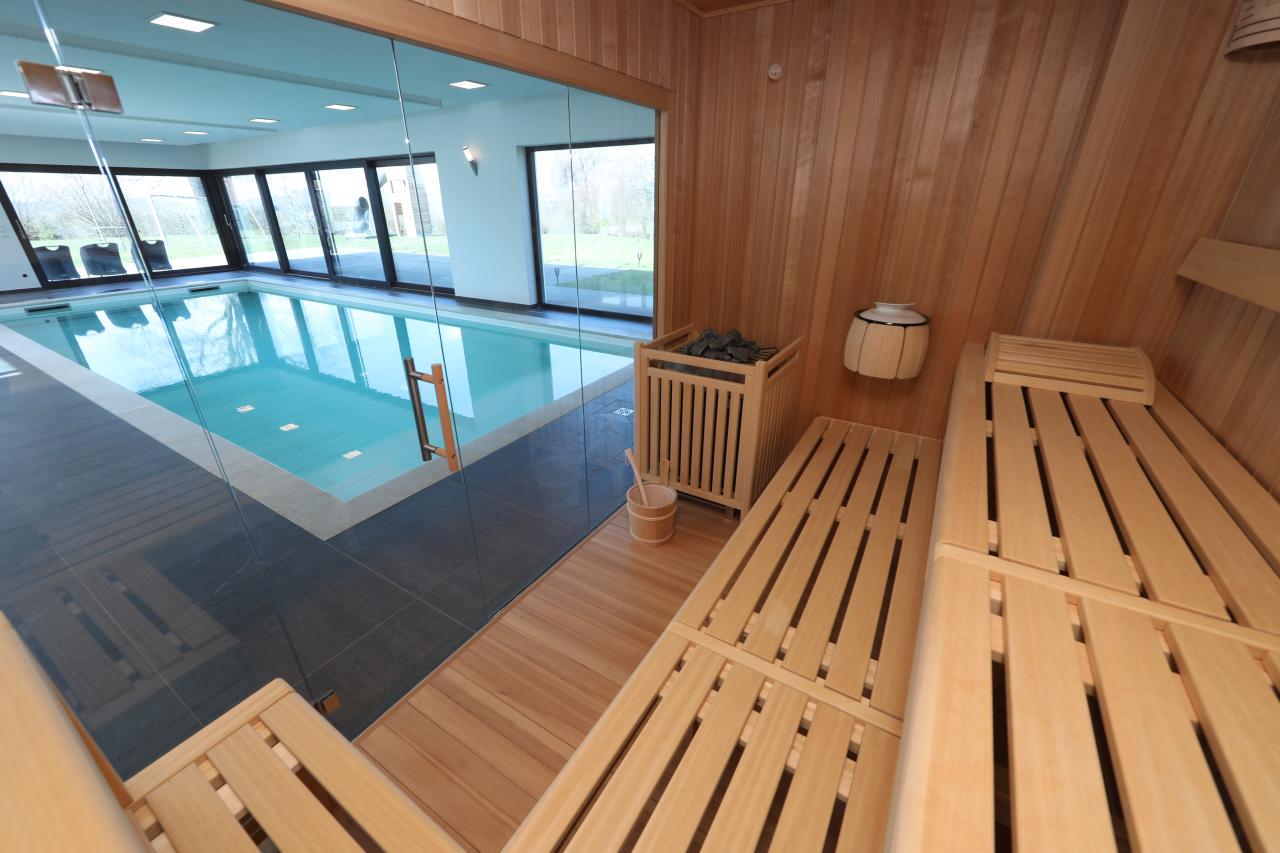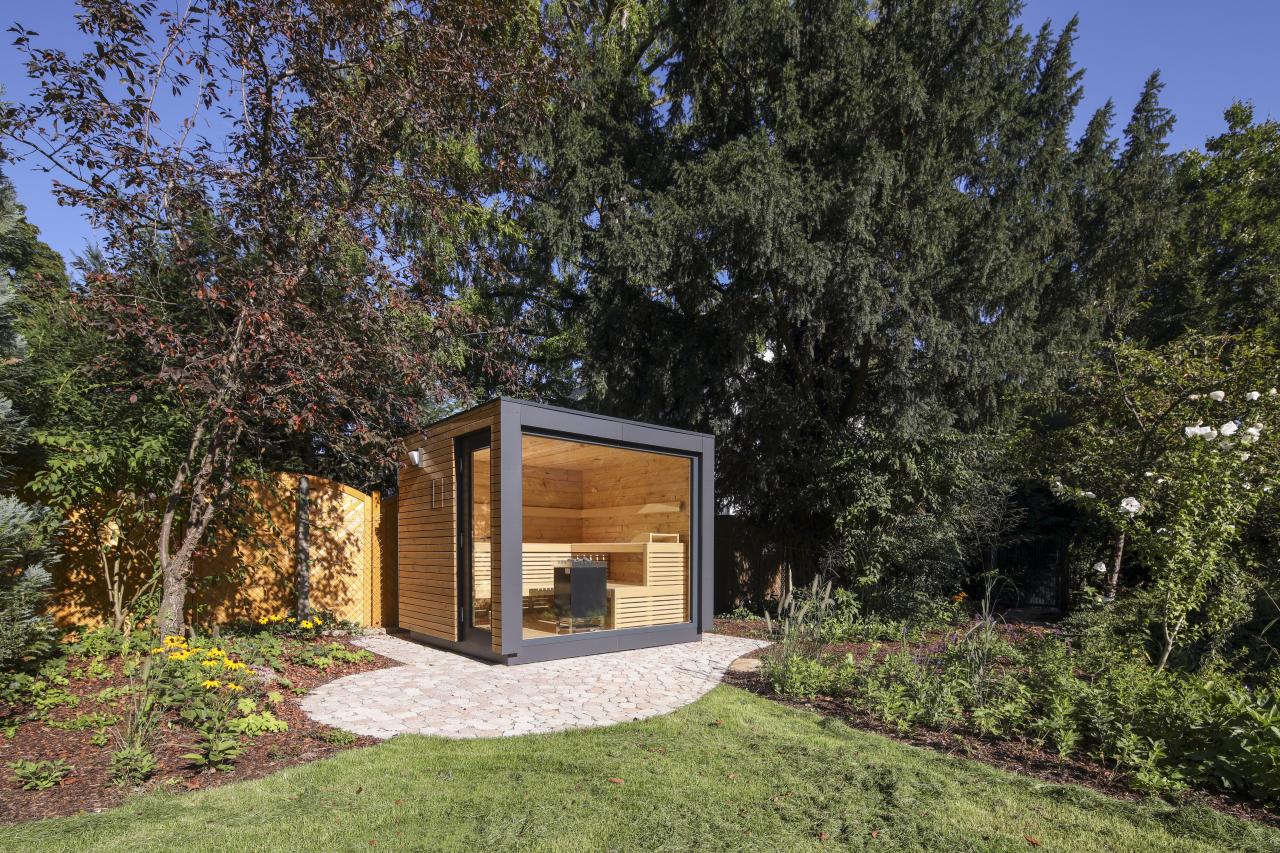The floor of your sauna is the foundation for a safe, hygienic and pleasant sauna experience. When planning your home sauna, the sauna floor therefore deserves special attention – after all, it must match the aesthetics and overall design of the sauna and also prove itself in terms of slip resistance, moisture resistance and heat conduction.
Whether you prefer natural wooden floors for a warm barefoot feeling or robust tile solutions with integrated drainage, at RUKU Sauna-Manufaktur we provide individual advice and find the sauna floor that perfectly suits your space and your requirements.
Sauna flooring – Which flooring is best for a sauna?
What requirements should a sauna floor meet?
A sauna floor must do more than just look good. It is exposed to daily changes in temperature, humidity and mechanical stress – and should always meet standards of comfort and safety. It should be non-slip, even in high humidity, and at the same time provide a pleasant walking experience, as sauna users usually walk on it barefoot. In addition, good moisture resistance is important for sauna flooring, as it must be able to withstand extreme temperature fluctuations, rising heat and condensation on a permanent basis. Equally important is a hygienic surface that is easy to clean and does not absorb odours. Visually, the flooring should complement the design of the sauna and create a pleasant, harmonious atmosphere.
At RUKU Sauna-Manufaktur, we ensure that every sauna floor is robust and easy to maintain and that it blends harmoniously into the overall concept of your sauna – for a safe, comfortable and long-lasting sauna experience.

What kind of sauna flooring do I need? Floor coverings for your sauna
In this section, we present the most common floor coverings for saunas and explain the advantages and disadvantages of each material. This will help you determine which sauna floor you need. The most common floor coverings are:
Wooden floors
Tiles
PVC
Cork
Stone
Laminate
Wooden floors – the timeless classic
Wood is the most traditional flooring material for saunas and creates a particularly natural and cosy atmosphere. Wood has low thermal conductivity by nature, which means that the sauna floor does not get too hot or too cold. This makes it perfect for walking barefoot without burning your feet. Wood types commonly used for sauna floors are Nordic spruce or Canadian hemlock. The main advantage of wood is that it stores heat and releases it evenly. Another plus point is the non-slip properties of wooden flooring. However, compared to other materials, wood is more sensitive to moisture and requires longer drying periods after each sauna session.
Tiles – A robust and easy-care alternative
Tiles are a popular choice for saunas due to their robustness and ease of maintenance. Tiles do not absorb moisture and are therefore very hygienic and easy to clean. Ceramic tiles remain pleasantly cool and fit perfectly into modern interiors. Stoneware tiles create a rustic yet elegant look. An important consideration when choosing tiles for a sauna floor is slip resistance. Tiles also have the advantage of remaining durable even in humid environments such as saunas. However, especially in larger areas, they can create a cooler atmosphere, which not every sauna lover finds pleasant.
PVC – Modern and durable
PVC floor coverings are a very modern, easy-care and durable solution for saunas. They are characterised by their resistance to chemical and mechanical stress and are also water-resistant and non-slip. As PVC sauna floors are available in many different colours and patterns, you can customise your sauna even further.
Cork – The natural and elastic floor covering
Cork is an environmentally friendly, elastic floor covering for saunas. The material is pleasantly warm and non-slip. Cork also has insulating properties and thus contributes to heat retention in the sauna. However, cork is also susceptible to moisture, similar to wood, and needs to be thoroughly dried after each sauna session. Due to its soft structure, cork can wear out more quickly with intensive use – sauna lovers can only counteract this with thorough care.
Stone – The robust and elegant sauna floor
Stone flooring gives saunas an elegant, rustic look. Natural stones such as granite are particularly robust and resistant to high temperatures and moisture. The advantage: stone floors are naturally non-slip and a very durable solution for saunas.
The disadvantage of stone floors is that they are often perceived as cool, which is not always considered pleasant in a sauna. However, this can be mitigated by using underfloor heating or choosing warmer types of stone.
Laminate – moisture-resistant laminate for saunas
Special moisture-resistant laminate flooring is a practical and easy-care choice for saunas. It is particularly resistant to moisture and heat, making it ideal for use as sauna flooring. Moisture-resistant laminate flooring differs from conventional laminate flooring in that it has a special sealant that makes it resistant to the challenges of a sauna environment. A particular advantage is that laminate has the look of wood without the risk of mould growth.
Which wood is suitable for the sauna floor?
With RUKU Isoholzböden, you can enjoy a noticeably improved indoor climate thanks to optimal thermal insulation provided by the innovative Isoholz multi-chamber system. The integrated insulation chambers offer effective protection against cold floors. Best of all, the walking surface, sealed with liquid wax that is harmless to health, is even sauna-proof. Choose between Nordic spruce and Canadian hemlock. At our RUKU sauna factory, we carefully select each piece of wood – giving your sauna floor aesthetic elegance and maximum functionality.

Sauna flooring for various types of saunas
Outdoor sauna: For outdoor saunas, which are more exposed to the elements, we recommend a particularly robust and weather-resistant sauna floor. Wood remains the preferred choice here, as it stores heat well and creates a natural ambience. In combination with our Isoholz insulation, the floor meets the highest functional and aesthetic standards.
Indoor sauna: In indoor saunas, which are less exposed to extreme external conditions, you can choose the flooring according to your personal preferences. Wood creates a cosy atmosphere, but tiles or laminate flooring conjure up a modern look. The choice here depends primarily on your aesthetic preferences.
Infrared cabin: In an infrared cabin, the floor is usually already integrated, and solid wood is generally used to distribute the heat evenly and create a harmonious overall look.
High-quality saunas including sauna flooring in RUKU premium quality
With over 170 years of experience in sauna manufacturing, RUKU combines tradition and modern technology in the production of exclusive saunas. We offer you not only the highest quality, but also individually designed saunas that are perfectly tailored to your needs. At RUKU, we attach great importance to craftsmanship, the selection of high-quality materials and innovative solutions such as our Isoholz technology. Every RUKU sauna is individually planned and manufactured according to your wishes and requirements. This also applies to the sauna floor, which we offer in various types of wood and designs. Our exclusive Isoholz insulation ensures that the sauna floor remains exceptionally durable and resistant.
Trust in our expertise and let the quality of a custom-made RUKU sauna convince you. Contact us now for your personalised, made-to-measure home sauna!
Phone
+49 7303 90510Frequently asked questions (FAQ)
What type of flooring should be used in a sauna?
The sauna floor must be heat-resistant, non-slip and moisture-resistant. Wood is the preferred choice here, as it is natural, warm and durable. However, tiles, stone, cork, laminate or PVC can also be used as sauna flooring, especially for indoor saunas.
Can you put a sauna on vinyl flooring?
PVC sauna flooring or vinyl flooring is generally possible in a sauna, but wood is the better choice for sauna flooring due to its natural properties such as heat distribution and moisture resistance. Vinyl can warp at high temperatures and humidity, which is why wood is usually preferable.